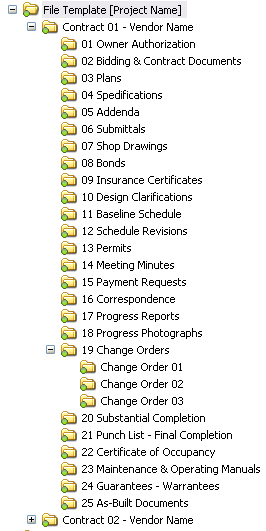From Chaos to Control: Harnessing the Potential of Construction Document Management
From Chaos to Control: Harnessing the Potential of Construction Document Management
Blog Article
Optimizing Project Cooperation: Designer's Best Practices in Building And Construction Record Administration
In the elaborate world of architectural tasks, the reliable administration of building documents stands as a keystone for success. Designers, with their thorough interest to detail and ingenious layout services, are entrusted with orchestrating a harmony of sources, timelines, and stakeholders. Nevertheless, among this complexity lies a sixty-four-thousand-dollar question: just how can architects enhance cooperation processes to improve task results? By checking out key methods such as leveraging cloud-based systems, developing robust communication procedures, and ensuring data protection, engineers can elevate their paper monitoring practices to new elevations.
Leveraging Cloud-Based Systems
Leveraging cloud-based systems is a basic strategy for contemporary engineers in maximizing building and construction document management processes. By transitioning from typical paper-based systems to cloud services, designers can simplify cooperation, boost document ease of access, and improve total project effectiveness. Cloud-based systems supply engineers the capacity to shop, share, and update construction records in real-time, making certain that all employee have accessibility to one of the most existing details despite their location. This access advertises seamless interaction and sychronisation among task stakeholders, causing fewer mistakes and delays in the construction procedure.
Additionally, cloud-based platforms offer a safe setting for saving delicate task info, offering encryption, normal backups, and user authorization setups to protect data honesty. Engineers can also take advantage of the scalability of cloud remedies, allowing them to change storage space ability and functionality based on task requirements. In general, leveraging cloud-based systems empowers architects to enhance their building and construction file monitoring procedures, driving greater partnership, performance, and success in their projects.
Carrying Out Version Control Solution
Having developed the benefits of cloud-based platforms in building and construction document management, engineers can now boost their record control processes by applying Version Control Equipment. Version Control Equipment (VCS) are vital tools that track modifications in files, ensuring that group participants are always collaborating with the most up to date and most accurate info. By implementing VCS, engineers can maintain a centralized database where all task files are saved, making it possible for seamless partnership while lessening the danger of mistakes and version problems.
One key advantage of Version Control Solution is the capacity to track the full background of record modifications, allowing individuals to change to previous versions if required (construction document management). This feature is specifically beneficial in construction tasks where design versions and adjustments are usual. VCS assists in far better interaction among team members by offering a clear audit path of who made particular modifications and when they were made. This transparency not only boosts accountability yet additionally helps in solving disputes or discrepancies that may arise during the project lifecycle.
Developing Interaction Procedures
To make certain effective and effective project sychronisation, engineers must establish clear and durable interaction protocols within their building record management processes. Interaction protocols define the techniques, regularity, and channels with which staff member exchange info, updates, and responses. One crucial aspect of developing these procedures is establishing a centralized interaction system where all project-related discussions and record sharing can happen. This platform could be a project monitoring software program, e-mail strings, or cloud-based storage space remedies. By setting standards on exactly how info is distributed and exactly how staff member communicate with each various other, engineers can enhance the circulation of information and avoid miscommunications or delays in the building procedure.
Additionally, interaction methods need to also consist of standards on exactly how to deal with conflicts, modification orders, and urgent problems that might arise during the job lifecycle. Establishing a structured method to communication ensures that all stakeholders are on the very same web page, advertises openness, and inevitably adds to the successful conclusion of the building project.
Utilizing BIM Software Application for Sychronisation
BIM software plays a critical duty in boosting sychronisation amongst job employee in the construction sector. Building Details Modeling (BIM) promotes collaboration by providing a central system where architects, designers, service providers, and other stakeholders can collaborate in a coordinated way. Through BIM software program, job participants can access and update a shared design which contains in-depth details concerning the building style, building and construction components, and job timetables.

In addition, BIM software application official site makes it possible for real-time collaboration and communication among staff member, no matter their physical location. With cloud-based BIM systems, task stakeholders can access the most recent learn the facts here now task information, track changes, and make informed decisions promptly. Overall, leveraging BIM software for coordination enhances task effectiveness, performance, and eventually brings about effective task results.
Ensuring Data Safety And Security and Compliance
In the world of building file administration, safeguarding information honesty and making sure governing conformity are paramount considerations for architects and various other project stakeholders. Engineers have to apply durable security measures to safeguard sensitive job info from unauthorized accessibility or violations. Utilizing safe and secure cloud storage space solutions with file encryption methods and access controls can assist minimize risks related to data theft or loss. Consistently updating software application and systems, performing security audits, and offering personnel training on information security best methods are essential steps in preserving a safe environment for construction file administration.

Conclusion
To conclude, engineers can optimize task cooperation in building and construction file management by leveraging cloud-based systems, carrying out version control systems, developing communication protocols, making use of BIM software for control, and making certain information security and compliance. These ideal techniques aid simplify the building and construction process, improve interaction among task stakeholders, and improve efficiency learn this here now in task shipment. By adhering to these guidelines, architects can properly handle construction records and facilitate effective project end results.
Via BIM software, task participants can access and update a common model that consists of comprehensive information concerning the structure layout, construction parts, and job timetables.
With cloud-based BIM systems, project stakeholders can access the most current task info, track modifications, and make informed choices without delay - construction document management. In general, leveraging BIM software application for control enhances project efficiency, performance, and ultimately leads to effective job end results
In verdict, architects can optimize project collaboration in building paper monitoring by leveraging cloud-based systems, carrying out version control systems, developing interaction procedures, using BIM software application for sychronisation, and making sure information security and conformity. These ideal practices help streamline the construction process, enhance interaction amongst task stakeholders, and boost efficiency in project delivery.
Report this page